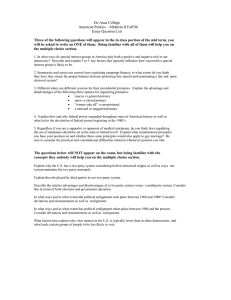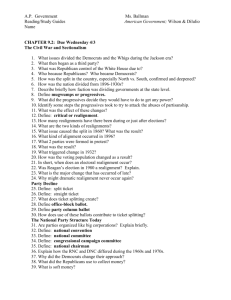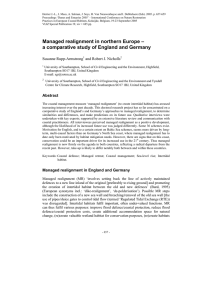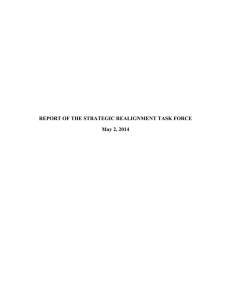Coastal and estuarine managed realignment: design issues (PDF
advertisement
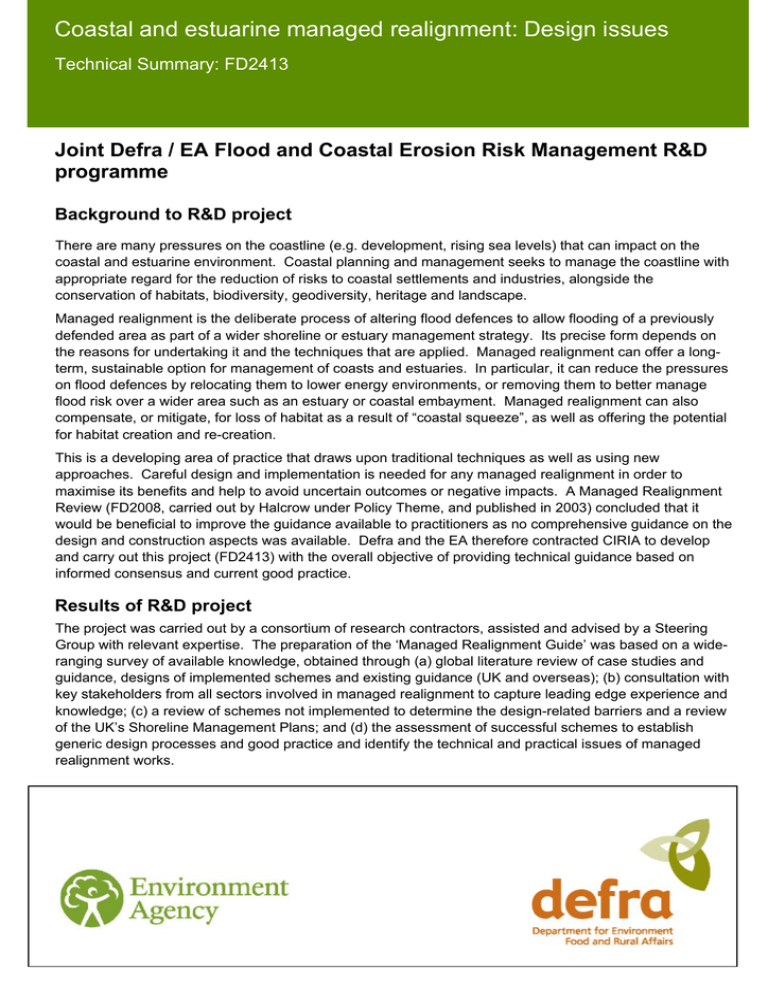
Coastal and estuarine managed realignment: Design issues Technical Summary: FD2413 Joint Defra / EA Flood and Coastal Erosion Risk Management R&D programme Background to R&D project There are many pressures on the coastline (e.g. development, rising sea levels) that can impact on the coastal and estuarine environment. Coastal planning and management seeks to manage the coastline with appropriate regard for the reduction of risks to coastal settlements and industries, alongside the conservation of habitats, biodiversity, geodiversity, heritage and landscape. Managed realignment is the deliberate process of altering flood defences to allow flooding of a previously defended area as part of a wider shoreline or estuary management strategy. Its precise form depends on the reasons for undertaking it and the techniques that are applied. Managed realignment can offer a longterm, sustainable option for management of coasts and estuaries. In particular, it can reduce the pressures on flood defences by relocating them to lower energy environments, or removing them to better manage flood risk over a wider area such as an estuary or coastal embayment. Managed realignment can also compensate, or mitigate, for loss of habitat as a result of “coastal squeeze”, as well as offering the potential for habitat creation and re-creation. This is a developing area of practice that draws upon traditional techniques as well as using new approaches. Careful design and implementation is needed for any managed realignment in order to maximise its benefits and help to avoid uncertain outcomes or negative impacts. A Managed Realignment Review (FD2008, carried out by Halcrow under Policy Theme, and published in 2003) concluded that it would be beneficial to improve the guidance available to practitioners as no comprehensive guidance on the design and construction aspects was available. Defra and the EA therefore contracted CIRIA to develop and carry out this project (FD2413) with the overall objective of providing technical guidance based on informed consensus and current good practice. Results of R&D project The project was carried out by a consortium of research contractors, assisted and advised by a Steering Group with relevant expertise. The preparation of the ‘Managed Realignment Guide’ was based on a wideranging survey of available knowledge, obtained through (a) global literature review of case studies and guidance, designs of implemented schemes and existing guidance (UK and overseas); (b) consultation with key stakeholders from all sectors involved in managed realignment to capture leading edge experience and knowledge; (c) a review of schemes not implemented to determine the design-related barriers and a review of the UK’s Shoreline Management Plans; and (d) the assessment of successful schemes to establish generic design processes and good practice and identify the technical and practical issues of managed realignment works. R&D Outputs and their Use The ‘Managed Realignment Guide’ provides comprehensive information to assist designers and managers to: • Improve the design and implementation of coastal and estuarine managed realignment projects. • Facilitate the wider and correct use of managed realignment. • Increase stakeholder confidence in managed realignment as an option for flood management. • Encourage more sustainable design and construction for flood management. • Help conserve and enhance natural coastal environments. The guide addresses realignment in both low-lying estuarine and coastal situations. Where coastal erosion is referred to it relates to erosion of intertidal areas and coastal features such as beach ridges or dunes, and not cliffs. The guide is divided into three parts to give an easily accessible structure for different users: PART I explains the objectives of managed realignment schemes. This is intended primarily for use by coastal and estuarine managers who would consider managed realignment as a policy option within a management strategy. It gives a general background to managed realignment, and considers success and failure criteria for different stakeholders and how these will have a bearing on site design issues. PART II considers whether managed realignment is appropriate for a particular site, and discusses how it might be delivered. This section has a more diverse audience, including geomorphologists, managers, planning authorities, environmental advisors and the informed public. Part II explains the decision process that leads to a preferred approach. PART III provides technical guidance on designing and implementing managed realignment schemes. This part is primarily aimed at modellers, engineers, environmental scientists and geomorphologists. The guidance covers the design, implementation, construction and monitoring phases. This R&D Technical Summary relates to R&D Project FD2413 and the following R&D output: Coastal and estuarine managed realignment – design issues. DJ Leggett, N Cooper & R Harvey Report C628 CIRIA, London, 2004 Publication Internal Status: Released Internally External Status: Released to Public Domain Defra/EA Project Manager: Michael W Owen, Coastal and Estuarine Advisor – Engineering Theme Research Contractor: CIRIA, Classic House, 174-180 Old Street, London EC1V 9BP Tel. +44 (0) 20 7549 3300 Website www.ciria.org CIRIA Project Manager: Marianne Scott CIRIA Research Contractor: Babtie Group, Simpson House, 6 Cherry Orchard Road, Croydon, CR9 6BE in conjunction with ABP Marine Environmental Research and the Halcrow Group. Report available at www.ciriabooks.com for purchase or for free PDF format download to Defra/EA users. The Defra/Environment Agency Joint R&D Programme was the lead funder for this collaborative project. SCOPAC, English Nature, Hampshire County Council, Teignbridge District Council and Countryside Council for Wales also contributed cash funding. Further copies of this summary are available from: Defra Flood Management, Ergon House, Horseferry Road, London SW1P 2AL Tel: 020 7238 6000 Info-fm:defra.gsi.gov.uk www.defra.gov.uk/environ/fcd/research
